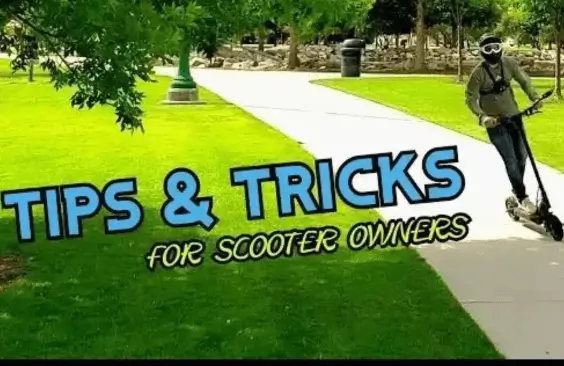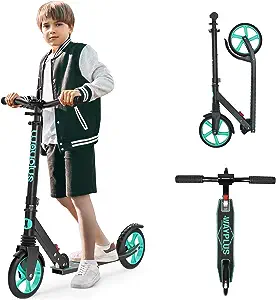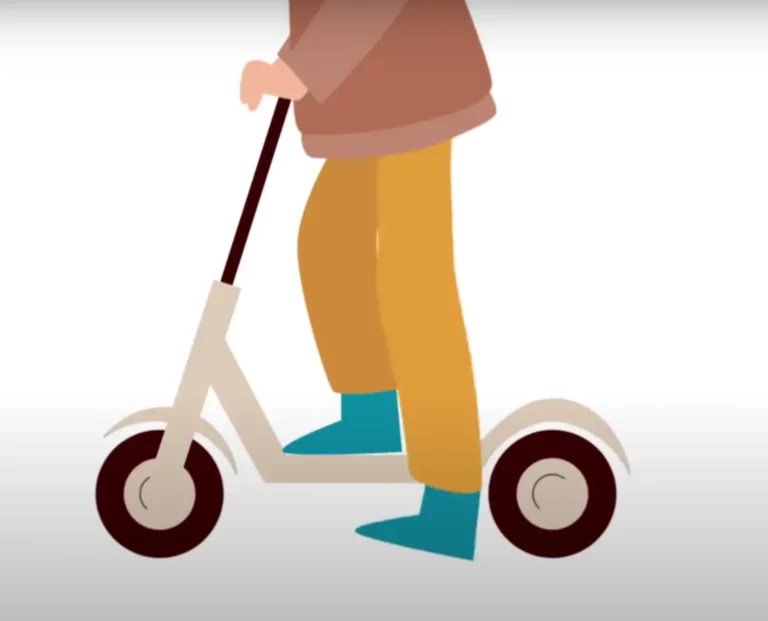Top 15 Electric Scooter Tips and Tricks for Beginners
Are you looking for the Electric Scooter Tips and Tricks for Beginners ? Look no further! Electric scooters have become increasingly popular in recent years, offering an eco-friendly way to get around town or enjoy a leisurely ride. Not only are they great for commuters, but they can also be a fun alternative to traditional transportation methods. If you’re new to the world of e-scooters or an experienced rider, here are some tips and tricks to make your ride smoother and safer.

Electric Scooter Tips And Tricks
Always Wear Protective Gear
Is an electric scooter safe? Yes, it is, but you have to take some precautions. First and foremost, it’s necessary to take protective gear when riding any electric vehicle. That includes a helmet, elbow pads, knee pads, gloves, and other safety equipment. Not only will this keep you safe while riding, but it will also give you peace of mind knowing that if anything were to happen during your ride, you are well protected.
Learn About the Local Laws
It’s also important to familiarize yourself with local laws regarding electric scooters, as they can vary greatly depending on your location. Some cities may limit where e-scooters are allowed on public roads or leagal on sidewalks, while others may require riders to have licenses to operate them legally. Therefore, being aware of the local regulations regarding electric scooters is paramount. Riding an electric scooter can be exciting, it’s important not to get too carried away. Speed limits should be respected at all times for both safety reasons as well as following local laws. Respecting speed limits is crucial for ensuring safety on the roads and adhering to local laws. However, in certain cities where higher speeds are permitted for scooters, you can still enjoy the increased speed responsibly by following the steps outlined in how to make kick scooter faster or how to remove speed limiter on electric scooter.
Get Familiar With the Control Mechanism of Your Scooter
Before riding a scooter, it is necessary to make sure you are familiar with the control mechanisms and safety features. First, locate the accelerator, brakes, lights, and horn so that you know exactly where they are while riding. Bring your scooter to a protected outdoor area, such as a parking lot or empty street, and practice controlling it without power on. You will get a sense of how the brakes and throttle feel. That will help you become more confident in riding the scooter safely. Learn to fold up the scooter correctly. Know about other safety features of your scooter, such as reflectors and lights, so that you are visible while riding at night or in low-light conditions. Taking time to familiarize yourself with all aspects of the scooter’s control systems is essential for ensuring safe operation and will give you greater peace of mind when using it for transportation or recreation.
Perpendicularly Cross the Obstacles
Perpendicularly rolling over obstacles requires a bit more skill and finesse. When rolling over an obstacle perpendicular to your direction of travel, it is best to start by unweighting the rear wheel. You can achieve that by pressing down on the left pedal while quickly pulling up on the right handlebar. While lifting the rear wheel, keep your eyes fixed on a point beyond the obstacle. That will help you how to balance as you roll over it. After that, shift your weight towards the front wheel while continuing to look ahead and tugging lightly on the handlebars. That will cause enough lift for the front wheel to glide over the obstacle without gaining significant air or losing speed. If you’re having difficulty clearing an obstacle perpendicularly, try angling your approach slightly to give yourself some extra momentum when hopping your front wheel over it.
Always Look Forward to Sidestepping Obstacles
Always look ahead when riding a scooter to anticipate and avoid any obstacles that may be present. Always be aware of the road surface and surroundings – looking for potholes, cracks, debris, and other vehicles on the road. Doing this will help you prepare the movements needed to maneuver any obstacle. Furthermore, practice making quick but controlled avoidance movements to become confident in your abilities and reactions.
When navigating around an obstacle, try not to overcorrect or swerve into another vehicle, as this can lead to a dangerous situation. If possible, go around or through it rather than attempting to jump it, as this can cause instability and potential damage to the scooter itself.
Quickly Review the Scooter Before Every Ride
It is helpful to do a pre-flight check to make sure your scooter is safe and ready for the ride.
- Check the condition of the tires, inflate them to correct pressure, and look for any cuts or punctures.
- Ensure that the folding mechanisms are working correctly. Also, check that there is no damage or anything out of the ordinary.
- Adjust brakes if necessary and test that you can safely stop.
- Look over the e-scooter for anything unusual and investigate further if needed.
- Check battery level for the planned trip and bring extra batteries if needed.
- Have a gear bag with tire slime, a pump, and a multi-tool in an emergency.
- Bring along your mobile phone for emergencies as well
Relax Your Posture While Riding
Straight your back and relax your posture while riding the scooter. Make sure you don’t slouch over or tense up any part of your body, as this may cause strain on your spine. Instead, focus on keeping an erect but comfortable position, with your back held tall and arms at 90-degree angles when possible. Adjust the height of the handlebars to fit your sitting position so that it won’t force you into an awkward angle, and make sure to keep a neutral grip on the handlebars. Also, do not lean too far forward, as it can add more stress to your lower back. Taking occasional breaks while riding helps reduce fatigue in the long run and allows you to adjust your posture if needed.
Balance Your Feet Movement
Your front foot (right foot for right-handed people) should point slightly forward and diagonally left. Point your back foot slightly to the side (left one for right-handed people). You can also face more toward the left for improved balance and stability. The best distance between your feet will depend on the length of the scooter deck.
Drive With Your Feet
Steering with your feet and body can make turning more comfortable and intuitive. To do this, gently move your entire body weight in the direction you want to turn, not just your feet. That helps shift the center of gravity in the right direction and maintain balance while riding. Moving your body also provides extra stability if you’re navigating through rough terrain or unexpected speed bumps. The key is to make sure the movement is subtle and slow so that you don’t lose control of the bike. It’s also important to note that using your feet to steer strengthens your core as it helps you maintain a balanced posture. Practicing this technique will build up muscle memory.
Firmly Hold Your Handlebars
It is essential to have a firm grip on the handlebars while riding. Otherwise, you will lack control and find yourself on the ground. However, be careful not to squeeze too hard, as this can be uncomfortable and cause fatigue in your hands and arms. That is why it’s essential to maintain a balance between having a secure hold and not applying too much force; this way, you can achieve better control without having to bear the burden of holding tight.
Place Your Finger on the Brake
It is necessary to keep at least one finger on the brake lever while riding an electric scooter. That may seem like common sense, but it is often forgotten or overlooked when getting caught up in the excitement.
Have a Complete Focus While Riding
Focus while riding is essential to your safety and the people around you. When cycling, take caution and remain aware of your surroundings. Be sure to keep an eye out for pedestrians, oncoming traffic, or any other potential barriers. Follow the rules of the road and be sure to follow along paths with many people present. Additionally, stay away from areas populated by wild animals or other creatures that can cause harm. Ensure you wear protective attire, such as helmets and reflective clothing, so you can be seen when riding in lower light conditions.
Do Not Ride on Slippery Roads
Avoid slippery surfaces at all costs when riding an e-scooter. It is because wet surfaces such as marble tiles, metal surfaces, wet streets, and muddy sidewalks can be extremely hazardous due to the lack of friction between the tires and the roads. That can result in control loss over your scooter, potentially causing injury to you and others around you. Be extra vigilant while cruising on wet terrain, and always maintain a slow speed. Avoiding roads with standing water or large puddles is also recommended, as these can cause significant issues with traction and stability.
Do Not Ride in Unfavorable Conditions
It is always essential to avoid unfavorable riding conditions while using an electric scooter. Such conditions can include natural elements such as rain, snow, and high winds, as well as unnatural elements such as rough road conditions, low light, crowds, and uneven pavement. Always avoid uneven pavement when on an e-scooter since they are designed primarily for level surfaces. Uneven pavement can cause the rider to lose control or even fall off the scooter. Low light conditions can also be hazardous and increase the risk of an accident. In addition, high winds should be taken into consideration when going on a ride with an e-scooter. The wind can make it difficult for you to keep your balance or stay on course during your ride, which could lead to dangerous situations if you’re not careful enough.
Take Your Ride Easy
Learning how to ride an electric scooter may not come as quickly and efficiently as other activities, such as riding a bicycle, but it is doable. Taking your time and allowing yourself to learn at a comfortable pace is essential. It’s important to remember that teaching yourself the basics will take practice and patience – everyone is different and learns differently. Starting at a slow speed can be beneficial in terms of safety. Take it easy when learning how to brake, accelerate, turn and maneuver the scooter properly. That will help you become more comfortable controlling the scooter before increasing your speed. Finally, take some time to read through the user manual for instructions on maintenance and repair procedures should something go wrong with your scooter during use.
Tips to Maximize Your Range on Scooter

Maximizing your range on a scooter is possible. Follow these tips to get some help:
- Always kick-start your scooter.
That will efficiently transfer kinetic energy from the motor to the wheels. It will reduce the amount of energy used in the process. Additionally, when starting the scooter, it is best to be gentle and gradual with acceleration, as applying too much torque can quickly exhaust the battery’s capacity.
- Accelerate slowly and keep a low top speed.
When accelerating quickly or driving at high speeds, you will require more power from your motor, which increases the time needed until recharging is necessary. To extend your range, keep your maximum speed low while being safe and aware of your surroundings.
- Keep tires inflated to their recommended pressure level.
If you’re constantly riding on deflated tires, it will affect how efficiently they roll and thus reduce your range significantly due to extra drag caused by air resistance within the tire’s treads. Check your tire pressure before using the scooter. So you will not have to worry about this issue.
- Ride during warmer weather.
Cold temperatures will reduce battery performance and shorten its lifespan over time. When the temperature drops, you may notice your engines and batteries powering down a little earlier than usual. Sadly this phenomenon is often caused by reduced conductivity levels in these materials during cold conditions – compromising their connections to each other! That can lead to preventable problems like flat batteries or shortened run times; it might be worth checking ahead before setting out on those winter rides.
- Utilize regenerative braking systems if available on your scooter model.
Make use of regenerative braking systems if they’re available on your scooter model. No need to lose energy through heat thanks to friction – let the electric current recaptured from this processing power and extend the life of your battery, ensuring ultimate mileage with every turn.
- Maintainance is important.
Make sure to take good care of your electric scooter by regularly maintaining it according to manufacturer instructions. Some precautions like checking tire pressure or replacing worn-out components will save time and money while ensuring that your e-scooter runs correctly. Taking these simple steps into account before each ride can make all the difference. Now have a safe and enjoyable experience with your electric scooter!
Conclusion:
In conclusion, electric scooter riding is a great way to get around quickly and efficiently, but it’s better to take some precautions for your safety. Taking these tips into account will help ensure you have a safe and enjoyable riding experience every time you go out on your electric scooter! Follow our blog for more updates and let us know your queries in the comments below.
Frequently Asked Questions (FAQs)
- How to make your scooter ride enjoyable?
One way to make your electric scooter ride more enjoyable is to invest in high-quality safety gear, such as a helmet, knee and elbow pads, and wrist guards. That will help protect you from injury in an unexpected bump or fall. Additionally, always keep your scooter charged and ready to go. A spare battery pack can be helpful in this regard so that you don’t have to worry about running out of charge mid-ride.
- How to improve the speed level of your scooter?
To make your electric scooter go faster, you will need to look into modifying the engine. That can involve tuning or replacing components such as the carburetor, CDI, ignition coil, and other parts. Tuning the system can help increase the power output of your scooter’s engine and thus make it travel at higher speeds. Additionally, replacing heavier parts like chassis and batteries with lighter alternatives is another way to reduce weight and improve acceleration. Finally, investing in better tires with extra grip and a higher maximum speed rating can also help boost performance.
- How to make your electric scooter last longer?
Maintaining the longevity of an electric scooter is necessary for getting the most out of your investment. Fortunately, following a few simple steps can help to keep your electric scooter running smoothly for years to come.
- Is an electric scooter worth it?
An electric scooter is worth it if you’re looking for an environmentally-friendly and fun way to get around. Electric scooters are much quieter than traditional gasoline-powered scooters, and they don’t require you to wait for a refuel. They’re also easier to maneuver and offer better acceleration than gas-powered options. Additionally, electric scooters are more efficient in energy consumption, so you’ll be able to enjoy your ride for longer. Furthermore, electric scooters come with many features that make them safe and convenient.







